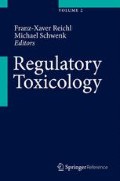Abstract
Due to the improved analytical methods, it is now possible to measure in man hazardous chemicals or their activation products in human blood and tissues. Biomarkers have been identified whose tissue level reflects the internal exposure resulting from all sources of uptake – including the contribution of endogenously occurring products (biological monitoring). One step further to risk assessment is the measurement of protein and DNA adducts (biochemical effect monitoring) which reflects the body burden with reactive metabolites. Applying these methods it turned out that in most cases not only the exposed but also not knowingly exposed controls had significant adduct levels. This raised questions about the existence of background exposures and their role for risk assessment.
Access this chapter
Tax calculation will be finalised at checkout
Purchases are for personal use only
References
Ewers U, Zwirner-Baier I, Neumann HG, Zelder E, Seuren-Kronenberg K (2000) Hämoglobin-Addukt Konzentrationen sprengstofftypischer nitroaromatischer Verbindungen im Blutr von Bewohnern von Rüstungsaltstandorten, Teil 2 Studie Stadtallendorf (ehemaliges DAG- und WASAG-Gelände) Umweltmed Forsch Praxis 5, pp 277–284
Kommission “Human Biomonitoring” des Umweltbundesamtes (1996) Konzept der Referenz- und Human Biomonitoring (HBM) in der Umweltmedizin. Bundesgesundheitsblatt 6/96
National Research Council (USA) (1974) Science and judgement in risk assessment. National Academy Press, Washington, DC
Neumann HG (2009) Risk assessment of chemical carcinogens and thresholds. Crit Rev Toxicol 50:449–461
Neumann HG, van Dorp C, Zwirner-Baier I (1995) The implication for risk assessment of measuring the relative contribution to exposure, environment and lifestyle: haemoglobin adducts from amino- and nitro-arenes. Toxicol Lett 82(83):771–778
Neumann HG, Thielmann HW, Gelbke HP, Greim H, Kappus H, Norpoth KH, Reuter S, Vamvakas P, Wardenbach HE (1997) Proposed changes in the classification of carcinogenic chemicals in the work area. Regul Toxicol Pharmacol 26:288–295
Senatskommission (2002) Senatskommission zur Prüfung gesundheitsschädlicher Arbeitsstoffe der Deutschen Forschungsgemeinschaft MAK- und BAT-Werte-Liste. Wiley-VC, Weinheim
Sugimura T, Nagao M, Wakabayashi K (2000) How we should deal with unavoidable exposure of man to environmental mutagens: cooked food mutagen discovery, facts and lessons for cancer prevention. Mutat Res 447:15–25
Author information
Authors and Affiliations
Corresponding author
Editor information
Editors and Affiliations
Rights and permissions
Copyright information
© 2014 Springer-Verlag Berlin Heidelberg
About this entry
Cite this entry
Neumann, HG. (2014). Background Exposure Versus Additional Exposure in Human Biomonitoring. In: Reichl, FX., Schwenk, M. (eds) Regulatory Toxicology. Springer, Berlin, Heidelberg. https://doi.org/10.1007/978-3-642-35374-1_60
Download citation
DOI: https://doi.org/10.1007/978-3-642-35374-1_60
Published:
Publisher Name: Springer, Berlin, Heidelberg
Print ISBN: 978-3-642-35373-4
Online ISBN: 978-3-642-35374-1
eBook Packages: Biomedical and Life SciencesReference Module Biomedical and Life Sciences

